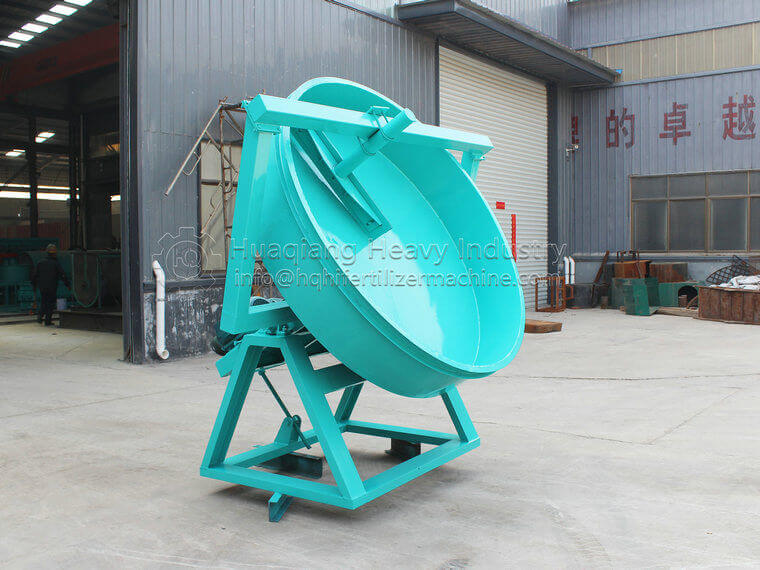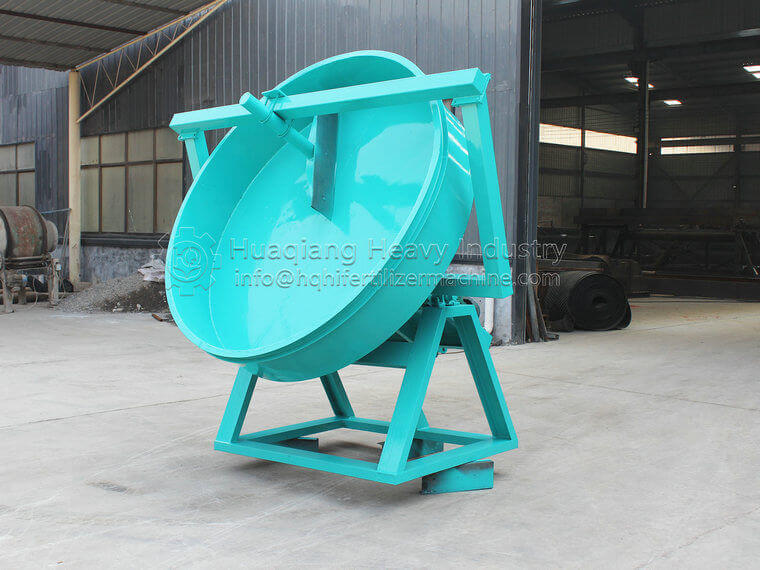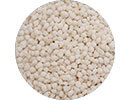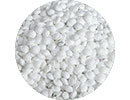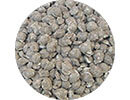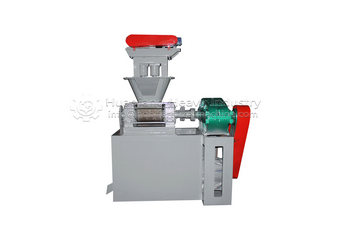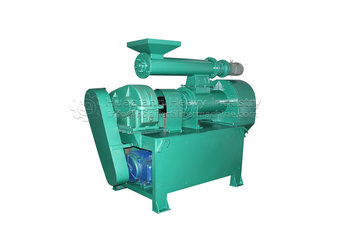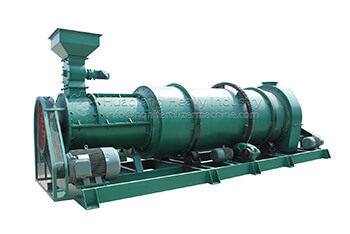The disc granulator is a widely used pelletizing machine. Its unique structure and operating principle make it a crucial tool in a variety of applications. The disc's rotation forces the material inside the disc under the combined effects of centrifugal force, friction, and gravity, gradually rolling it into balls. This transforms powdery or lumpy materials into granules.
The disc granulator is mainly composed of a disc, a transmission device, a frame, a feeding device, a water spray device, etc. Its core working component is a tilted disc, the tilt angle and speed of which can be adjusted according to the characteristics of different materials and granulation requirements.
Once the material enters the disc, it continuously slides and tumbles along its bottom as the disc rotates. Simultaneously, a water sprayer applies an appropriate amount of water or binder to the material, moistening the surface of the particles. Friction and centrifugal force gradually bind the small particles together, forming larger ones. As the particles grow larger, when their gravity exceeds the centrifugal force, they are ejected from the edge of the disc, completing the granulation process.
The disc granulator has the characteristics of simple structure, easy operation and low energy consumption. Compared with other granulation equipment, it has a strong adaptability to materials and can process a variety of materials with different properties. The granules produced have good sphericity, high strength and stable and reliable quality.
Where are disc granulators commonly used?
The disc granulator has a wide range of applications and performs well in many industries:
Fertilizer production field
It can be used to produce various organic fertilizers, inorganic compound fertilizers, biofertilizers, etc. For organic fertilizers, livestock and poultry manure, straw and other fermented materials can be made into granular fertilizers, which are not only convenient for storage and transportation, but also can improve the utilization rate of fertilizers.
In the production of inorganic compound fertilizers, basic fertilizers such as nitrogen, phosphorus, and potassium can be mixed in a certain proportion and granulated to produce compound fertilizers of different specifications and nutrient contents to meet the needs of different crops and soils.
Metallurgical Industry
It is suitable for granulating metal ore powder, such as iron ore powder, manganese ore powder, etc. After the ore powder is made into granules, it is convenient for subsequent processes such as sintering and smelting, which can improve resource utilization and reduce production costs.
building materials industry
It can be used to produce various building material particles, such as cement raw material particles, ceramsite sand, etc. In cement production, making cement raw material into particles can improve the combustion performance of the raw material and improve the quality of cement.
Chemical Industry
It can granulate various chemical raw materials, such as catalysts, pigments, detergents, etc. Through granulation, these chemical products can have better fluidity, stability and performance.
How is the disc granulator designed according to the granulation process?
The disc granulator consists of several key components, which work together to complete the granulation process:
disc
It is the core working part of the disc granulator, usually welded from steel plates. Its inner wall is usually paved with wear-resistant linings, such as rubber linings, polyurethane linings, etc., to improve the wear resistance of the disc and extend its service life.
The diameter and depth of the disc vary depending on production capacity, with common diameters ranging from 1 to 5 meters and depths from 0.3 to 1.5 meters. The disc's tilt angle can be adjusted using an adjustment device, typically between 30° and 60°.
transmission
It consists of a motor, a speed reducer, a pulley, a coupling, etc. The motor provides power, which is reduced by the speed reducer and drives the disc to rotate. The performance of the transmission device directly affects the speed stability of the disc, which in turn affects the granulation quality.
The rotation speed of the disc can be adjusted according to needs, generally within the range of 5-30 rpm.
frame
Used to support components such as discs and transmission devices, it is usually welded with steel sections and has sufficient strength and rigidity to ensure the stability of the equipment during operation.
Feeding device
It mainly consists of a hopper and a feeder, which are used to evenly and stably add materials to the disc. Feeder types include screw feeders, belt feeders, etc. The appropriate feeding method can be selected according to the characteristics of the material.
Water spray device
It consists of a water pipe and nozzles, and is used to spray water or adhesive onto the material in the disc. The number and position of the nozzles can be set according to the size of the disc and the distribution of the material to ensure that the material is evenly wetted.
How does the disc granulator make fertilizer?
The granulation process of the disc granulator is relatively simple and mainly includes the following steps:
Raw material pretreatment
The raw materials to be granulated are pre-treated, such as crushing, screening, mixing, etc. The raw materials are crushed to a certain particle size, generally required to be between 0.1-1 mm, to ensure the granulation effect and uniformity of the particles.
For raw materials with different ingredients, they need to be fully mixed so that the ingredients are evenly distributed.
Adding material and spraying water
The pre-treated raw materials are added to the disc through the feeding device. At the same time, the water spray device sprays the materials with an appropriate amount of water or binder. The amount of water or binder added should be controlled according to the characteristics of the material and the granulation requirements. Generally, the moisture content of the material is maintained between 10% and 20%.
Granulation process
As the disc rotates, the material tumbles, collides, and bonds inside the disc, gradually forming granules. During the granulation process, the disc's rotation speed, tilt angle, and the amount of water or binder added need to be adjusted according to the granule formation process to ensure granule quality and yield.
Particle screening
The particles discharged from the edge of the disc are screened by the screening equipment to separate the particles that do not meet the requirements (too large or too small) and return them to the granulation system for re-granulation. The qualified particles enter the subsequent drying, cooling and other processes.
What are the characteristics and advantages of disc granulator in fertilizer production?
The disc granulator has the following outstanding advantages:
Good granulation effect
The particles produced have high sphericity, generally reaching more than 80%, smooth surface, good particle uniformity, and high strength, which can meet the particle quality requirements of different industries.
Easy to operate
The equipment has a simple structure, is easy to operate and master. The operator can effectively control the granulation process by simply adjusting the rotation speed, tilt angle of the disc and the amount of water or binder added.
Strong adaptability
It can process a variety of materials with different properties, whether they are powdery, small pieces or sticky materials, and can effectively granulate them. At the same time, it also has good adaptability to materials of different particle sizes and compositions.
Lower energy consumption
Compared with some other granulation equipment, the disc granulator has lower energy consumption and relatively low operating costs. This is mainly due to its simple structure and efficient working method.
High production efficiency
It can produce continuously with high production efficiency. Depending on the equipment model, its hourly output can range from a few tons to dozens of tons, which can meet the needs of production of different scales.
What are the benefits of using a disc granulator to make fertilizer?
There are many benefits to using a disc granulator to make fertilizer:
Improve fertilizer quality
The resulting granular fertilizer has uniform nutrient distribution, ensuring that crops absorb nutrients evenly during growth. Furthermore, the granular fertilizer is strong and not easily broken during storage and transportation, reducing nutrient loss.
Easy to manage fertilizer
Granular fertilizers have good fluidity, making them easier to apply mechanically, improving fertilization efficiency and reducing labor intensity. Furthermore , their slow-release properties extend their shelf life and reduce the frequency of fertilization.
Improve soil environment
For organic fertilizer, after being granulated by the disc granulator, it can kill harmful substances such as pathogens and insect eggs, reducing soil pollution. At the same time, granular organic fertilizer can also improve the structure of the soil and increase soil fertility.
Improve resource utilization
Various agricultural wastes, industrial waste residues, etc. can be used as raw materials to produce fertilizers, realizing the recycling of resources and reducing the pollution of waste to the environment.
How to properly perform regular maintenance on the disc granulator?
In order to ensure the normal operation of the disc granulator and extend its service life, the following maintenance work needs to be done:
Regular inspections
Before starting the machine every day, check whether the connections of each component are tight and whether there is any looseness; check whether the transmission device is running normally and whether there is any abnormal noise; check the wear of the disc and deal with any abnormality in time.
Carry out a comprehensive inspection of the equipment every week, focusing on the temperature and lubrication of the bearings and the integrity of the seals.
Lubrication maintenance
According to the requirements of the equipment manual, regularly add lubricating oil or grease to the bearings, gears and other components of the transmission device to ensure their good lubrication and reduce wear.
The type and amount of lubricating oil or grease should meet the requirements of the equipment to avoid affecting the normal operation of the equipment due to improper lubrication.
Cleanliness and hygiene
After each production, clean the remaining material in the disc in time to prevent the material from agglomerating and hardening inside the disc, which will affect the next production. At the same time, clean the dust and debris on the surface of the equipment to keep the equipment clean.
Replacement of wearing parts
The wearing parts of the equipment, such as lining plates, nozzles, bearings, etc., should be checked regularly. If they are found to be severely worn or damaged, they should be replaced in time to ensure the normal operation of the equipment and the quality of granulation.
Safe operation
Operators should strictly follow the operating procedures to avoid equipment damage or casualties caused by improper operation. During the operation of the equipment, maintenance, adjustment and other operations are not allowed. If necessary, the equipment should be shut down and the power should be turned off.


